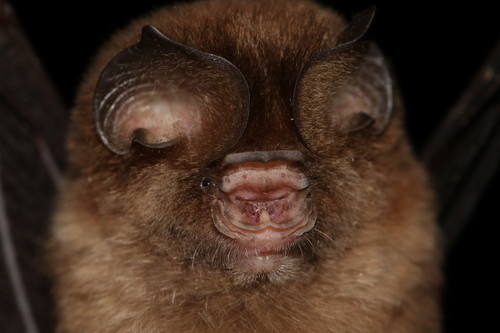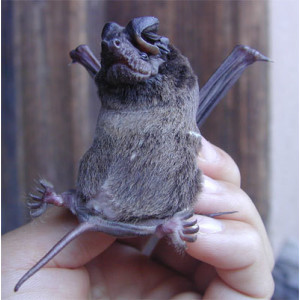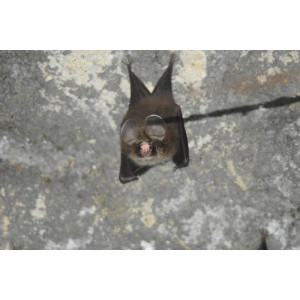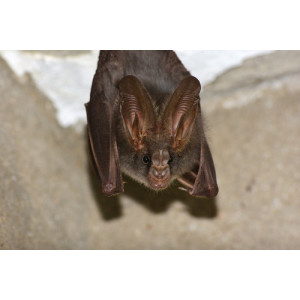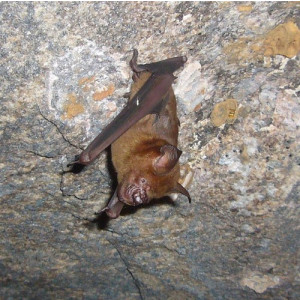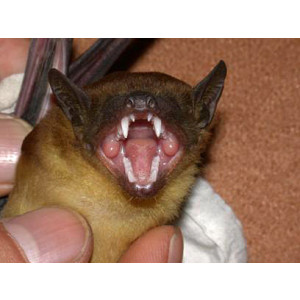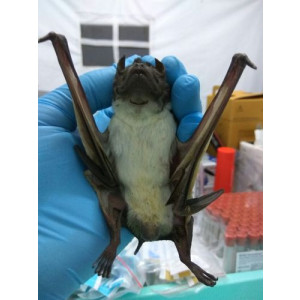Cantor’s Leaf-nosed Bat Did you see this animal?
Scientific Name : Hipposideros galeritus
Family : Hipposideridae
Order : Chiroptera
Class : Mammalia
Phylum : Chordata
Other Name : Cantor's Roundleaf Bat
Habitat : Forest, Rocky areas (eg. inland cliffs, mountain peaks), Caves and Subterranean Habitats (non-aquatic)
Description : These bats have a unique appearance, with brown or grayish-brown fur and large, round ears. Their most distinguishing feature, however, is the leaf-like projection on their nose, which is used to help them navigate their surroundings and locate prey. They are relatively small, weighing between 10 and 15 grams, and have a wingspan of around 25 cm.
Cantor's leaf-nosed bat is a nocturnal species, meaning that it is most active at night. They use echolocation to find their way around and locate their food, which consists primarily of insects like moths, beetles, and mosquitoes. They are also known to roost in groups in places like caves, tree hollows, and abandoned buildings.
In terms of reproduction, females give birth to one offspring each year, typically in the summer or early fall. The young are born with their eyes closed and rely on their mother for several weeks until they are able to fly and hunt on their own.
While Cantor's leaf-nosed bat is not currently considered to be a threatened species, it is important to protect their habitats from destruction and disturbance. Like many bat species, they play an important role in their ecosystem by serving as pollinators and controlling insect populations.
Overall, Cantor's leaf-nosed bat is an interesting and important species that is well-adapted to its environment. Its unique physical characteristics and nocturnal behavior make it an intriguing subject for study and observation. By taking steps to protect their habitats and promote their conservation, we can ensure that this species continues to thrive for years to come.
Cantor's leaf-nosed bat is a nocturnal species, meaning that it is most active at night. They use echolocation to find their way around and locate their food, which consists primarily of insects like moths, beetles, and mosquitoes. They are also known to roost in groups in places like caves, tree hollows, and abandoned buildings.
In terms of reproduction, females give birth to one offspring each year, typically in the summer or early fall. The young are born with their eyes closed and rely on their mother for several weeks until they are able to fly and hunt on their own.
While Cantor's leaf-nosed bat is not currently considered to be a threatened species, it is important to protect their habitats from destruction and disturbance. Like many bat species, they play an important role in their ecosystem by serving as pollinators and controlling insect populations.
Overall, Cantor's leaf-nosed bat is an interesting and important species that is well-adapted to its environment. Its unique physical characteristics and nocturnal behavior make it an intriguing subject for study and observation. By taking steps to protect their habitats and promote their conservation, we can ensure that this species continues to thrive for years to come.
Distribution in Bangladesh
References:
description written by:Asad U. Tanvir,Department of Zoology,Jagannath University,Dhaka; reviewed by:Muntasir Akash,Department of Zoology,University of Dhaka;Taxonomic Checklist:Red List of Bangladesh Volume 2: Mammals, 2015, IUCN; information sources:wikipedia,iucnredlist.org; photo credit:jakob(www.inaturalist.org/people/jakob), photo copyright: iNaturalist.more information please contact with us.
description written by:Asad U. Tanvir,Department of Zoology,Jagannath University,Dhaka; reviewed by:Muntasir Akash,Department of Zoology,University of Dhaka;Taxonomic Checklist:Red List of Bangladesh Volume 2: Mammals, 2015, IUCN; information sources:wikipedia,iucnredlist.org; photo credit:jakob(www.inaturalist.org/people/jakob), photo copyright: iNaturalist.more information please contact with us.
